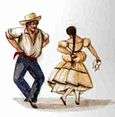Pancho Fierro

Francisco Fierro Palas, called "Pancho" Fierro (c.1807/09, Lima – 28 July 1879, Lima) was an Afro-Peruvian painter, known primarily for his costumbrista watercolors, which depict his country's life and customs.
Biography
He was baptized on the 5th of February, 1809, the son of Nicolás Rodríguez del Fierro, a priest, and a slave from the household of Nicolás' father, Don Antonio, a Colonel in the Militia Battalion. He had been manumitted upon his birth, following a rule that said no son of a Spaniard could be born a slave, but was raised by his mother's family.
There is no record of him receiving any artistic training, so he was probably self-taught. He married in 1828 and made his living by painting signs, making posters for bullfights and molding statues for nativity scenes. He also painted wall murals, all of which have been destroyed or covered over.
Today, he is remembered for his watercolors, painted on sign cards, depicting everyday scenes from Peruvian life. He created over 1200 of them and their popularity produced many imitators. The writer Ricardo Palma owned a large collection which his heirs gave to the City of Lima. They are now on display at the "Pinacoteca Municipal Ignacio Merino". The captions were provided by Palma, as Fierro may have been illiterate. Other large collections were acquired by the French painter Léonce Angrand and the Russian ethnographer Leopold von Schrenck, whose collection is now at the "Museum of Anthropology and Ethnography" in the Kunstkamera, Saint Petersburg.
According to an obituary in El Comercio, he died of paralysis in a hospital on Peruvian Independence Day.
Selected watercolors
- Peruvian Montonera
 Dancing the Marinera
Dancing the Marinera Carrying Aguardiente from Ica
Carrying Aguardiente from Ica

 Yendo a la iglesia
Yendo a la iglesia
Further reading
- Gustavo León y León Durán: Apuntes histórico genealógicos de Francisco Fierro: Pancho Fierro. Biblioteca Nacional del Perú, Fondo Editorial, Lima, 2004. ISBN 9972-874-47-8.
- Manuel Cisneros Sánchez: Pancho Fierro y la Lima del 800, Importadora, Exportadora y Librería García Ribeyro, 1975 ISBN 84-399-4470-5
- Raúl Porras Barrenechea and Jaime Bayly: Pancho Fierro, Ediciones del Instituto de Arte Contemporáneo, 1959
- José Sabogal Diéguez: Pancho Fierro: estampas del pintor peruano, Editorial Nova, 1945
External links
| Wikimedia Commons has media related to Pancho Fierro. |
- More watercolors @ the Biblioteca Luis Ángel Arango
- Video Documentary: "Vida y Obras de Pancho Fierro" (narration in Spanish) Part I, Part II, Part III